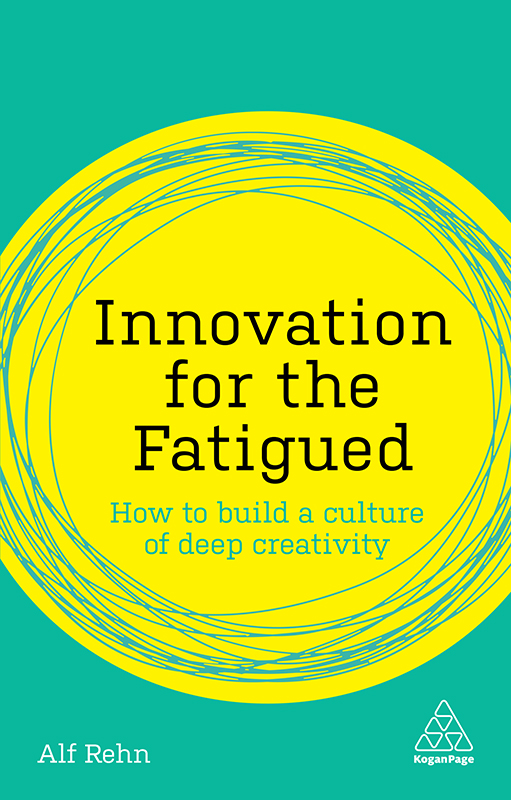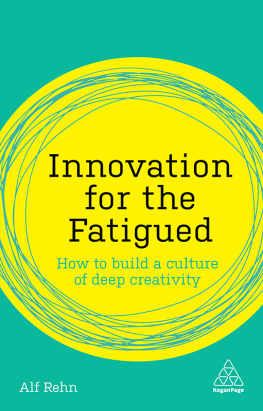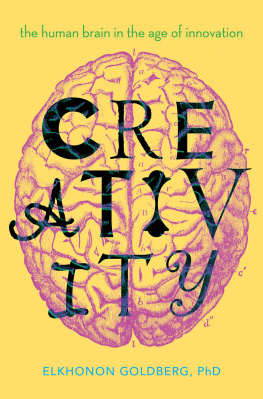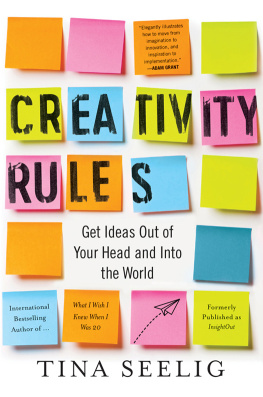Alf Rehn - Innovation for the Fatigued: How to Build a Culture of Deep Creativity
Here you can read online Alf Rehn - Innovation for the Fatigued: How to Build a Culture of Deep Creativity full text of the book (entire story) in english for free. Download pdf and epub, get meaning, cover and reviews about this ebook. year: 2019, publisher: Kogan Page, genre: Business. Description of the work, (preface) as well as reviews are available. Best literature library LitArk.com created for fans of good reading and offers a wide selection of genres:
Romance novel
Science fiction
Adventure
Detective
Science
History
Home and family
Prose
Art
Politics
Computer
Non-fiction
Religion
Business
Children
Humor
Choose a favorite category and find really read worthwhile books. Enjoy immersion in the world of imagination, feel the emotions of the characters or learn something new for yourself, make an fascinating discovery.
Innovation for the Fatigued: How to Build a Culture of Deep Creativity: summary, description and annotation
We offer to read an annotation, description, summary or preface (depends on what the author of the book "Innovation for the Fatigued: How to Build a Culture of Deep Creativity" wrote himself). If you haven't found the necessary information about the book — write in the comments, we will try to find it.
Alf Rehn: author's other books
Who wrote Innovation for the Fatigued: How to Build a Culture of Deep Creativity? Find out the surname, the name of the author of the book and a list of all author's works by series.
Innovation for the Fatigued: How to Build a Culture of Deep Creativity — read online for free the complete book (whole text) full work
Below is the text of the book, divided by pages. System saving the place of the last page read, allows you to conveniently read the book "Innovation for the Fatigued: How to Build a Culture of Deep Creativity" online for free, without having to search again every time where you left off. Put a bookmark, and you can go to the page where you finished reading at any time.
Font size:
Interval:
Bookmark:

More than ever, innovation has become a prime success factor, yet we all have experienced some kind of fatigue as the term has become a clich. In this book, Alf Rehn looks critically at the evolution of innovation practices throughout the past decades and teaches us new techniques on how to embrace innovation 4.0. An absolute must-read for anyone who wants to succeed, or just survive, in todays world.
ANTONIO NIETO-RODRIGUEZ, AUTHOR OF THE PROJECT REVOLUTION AND THE FOCUSED ORGANIZATION , AND NAMED WORLDS LEADING CHAMPION OF PROJECT MANAGEMENT BY THINKERS50
Some innovation is a quick fix, some takes a lifetime of dedication. Some new ideas are new products or services, while other new ideas bring revolutions in the way people live or think. In this important book, Alf Rehn urges leaders to reject wasteful stereotypes of creativity and to embrace the truths needed to deliver powerful real-world innovation. If innovation is deviance in practice, then Rehn is a most practical deviant.
DR MAX MCKEOWN, AUTHOR OF THE INNOVATION BOOK
Now that the global innovation hype bubble is bursting, the world desperately needs a dose of straight talk. Its time the clichs were put up against the wall and out of their misery. Alf Rehn brings his no-nonsense, shelve-the-bullshit style to this refreshing reset on what innovation is, what it can do, and how organizations might finally realize its value. He shows innovation isnt just about desire or a popular process, but requires deeper cultural intervention and an embedded mindset.
SCOTT SMITH, WORLD-LEADING FUTURIST AND FOUNDER OF CHANGEIST
This book has something of an intricate history. It has, at various times, been a critical diatribe on innovation, a manifesto for better innovation and an analysis of innovation discourses. Before it took the form you have before you, it has existed as at least two unfinished manuscripts and one published book. As a result, there are far too many people to acknowledge, and I will not even attempt such a list. Instead, I will keep it short and sweet.
I would like to thank Graldine Collard, who commissioned the book and made me believe that writing it would be a meaningful project. I would also like to thank my editor, Christopher Cudmore, who managed to curb some of my authorial excesses and gently encouraged me in the process, all whilst fretting over my cavalier attitude towards deadlines. I would also like to give a shoutout (as the young folks call it) to Marcus Lindahl, Ann Rippin, Karoline Kjellstedt, Anders Jensen, Niclas Lindgren and all my other friends who had to deal with or work around my, at times, lackadaisical focus and attention.
Most of all I want to thank my nearest and dearest. My older children, Sean and Line Rehn, both became adults (or a reasonable facsimile thereof) during the process of writing this book. My youngest child, the Nolskinator (aka Nol Muhr Rehn), has often interrupted the writing of this by insisting we do something more important, like get ice cream or play Bloons or Fortnite. All of them deserve my most heartfelt thanks.
My fondest and warmest thanks goes to my beloved partner Kate Hodsdon, who has been unwavering in her support as well as gracious in suffering the many pains having a writer as a partner can bring. She has been ever-present in the writing of this, and it is only fair to say the book exists because of her.
We live in a business world that increasingly worships the great tribal god innovation, lyrically hailing it not just as a desired, but as a necessary, condition of a companys survival and growth. This highly agitated confidence in the liberating efficacy of innovation has in some places become an article of faith almost as strong as the Natchez Indians consuming faith in the deity of the sun. Man creates gods according to his needs. Significantly, the businessmans new demigod and the Natchezs more venerable and historic god make identical promises. They both promise renewal and life.
Theodore Levitt in Innovative imitation , Harvard Business Review, September 1966
Between the shallows and the deep blue sea
As the births of living creatures are at first ill-shapen, so are all innovations, which are the births of time.
FRANCIS BACON
This is a book about innovation cultures and about why some cultures can engage with innovation on a deep level, whilst others get stuck in the shallow and superficial. But it is also a book with a warning. Despite the talk about innovation, despite the professed love for it, there is a lurking crisis at the heart of it all. A crisis that can be intimated from things both big and small. We shall start with the latter.
Scene 1 : The year is 2006, and I am a young, fresh-faced professor. I got tenure and a chair a few years previously, and I do have some experience in working with corporations. I have just arrived at the headquarters of a major such, and have been led to a large seminar room in which 100+ people sit and wait. The preamble has been dealt with, and I am introduced. I step up in front of the crowd and say Hello! My name is Alf Rehn, and I am here to help you with your innovation initiative.
The reaction is as immediate as it is positive. People smile, if sometimes just slightly, and you can notice a fair few people expectantly sitting up a little straighter. Some eyes twinkle, and not just from amusement. In the discussion that follows it becomes evident that people are enthusiastic about the idea of trying out new things, breaking old barriers and the like. This enthusiasm isnt necessarily evenly shared, but it is there.
Scene 2 : The year is 2018, and I am no longer quite as young. I am, however, very experienced when it comes to working on creativity and innovation in corporations. I arrive at the headquarters of a corporation much like the one in scene 1. I am led into a seminar room also very much like the one in the first scene, both when it comes to the look of the room and the look of the people gathered within it. The preamble is noticeably similar, as is my opening line: Hello! My name is Alf Rehn, and I am here to help you with your innovation initiative.
What follows, though, is markedly different. The smiles are still there, and there are many in the room who are clearly excited about it all. But it is no longer universal. Amongst the smiles are also looks of exhaustion and exasperation. Some in the audience look down-right dejected. In fact, I can hear a person muttering Oh no, not this again.
I do not offer these scenes as proof that Ive become markedly duller over the years. In fact, I often achieve better results in corporations now than I did 12 years ago. What I offer in these scenes might best be described as an insight into what has happened with innovation since the late 2000s. As the term went from battle cry to buzzword, and organization after organization started hunting for it in increasingly desperate ways, the manner in which innovation is understood and received underwent a transformation, and not always a happy one at that.
Whereas innovation is universally hailed as a critical business competence, the literal thing that organizations need to survive and succeed, it has also become something of a pain. In the mid-2000s, you might find the occasional larger organization that didnt run a yearly innovation initiative, or that didnt have an idea competition or recurring workshops on business model innovation. Today, theyre rarer than unicorns (both the startup and the horses with a horn kind). In the mid-2000s, a new innovation book was an interesting addition to the canon. Today, its frequently grist for the mill.
Next pageFont size:
Interval:
Bookmark:
Similar books «Innovation for the Fatigued: How to Build a Culture of Deep Creativity»
Look at similar books to Innovation for the Fatigued: How to Build a Culture of Deep Creativity. We have selected literature similar in name and meaning in the hope of providing readers with more options to find new, interesting, not yet read works.
Discussion, reviews of the book Innovation for the Fatigued: How to Build a Culture of Deep Creativity and just readers' own opinions. Leave your comments, write what you think about the work, its meaning or the main characters. Specify what exactly you liked and what you didn't like, and why you think so.










